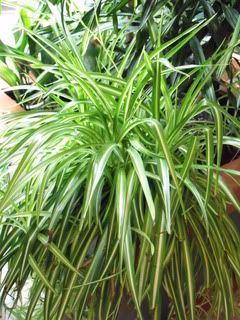
Water somewhat conservatively; the fleshy roots of Spider plant are well-adapted to drier conditions and will rot if the potting mix is left wet. Water well and then let the soil dry out pretty well. If the plantís leaves begin to look faded, it is just past time to water! Not much fertilization is needed so keep that to a minimum, as well. If you would like to fertilize, use a diluted solution infrequently. Every other month is plenty during the growing season and avoid it all together in the winter.
Mealy bugs are the most common pests on Spider plant. They can be hard to detect because they hide deep down between the leaves near the base of the plant. Scale insects can also sometimes be a problem.
Although unrelated to insects, brown, dead leaf tips can be a problem. This is caused primarily by the fluoride found in tap water. Contributing factors may be low humidity or too-infrequent waterings. Watering with rain water or distilled water is the best bet for stopping tip-burn. If you canít collect rain and you donít want to spend the money on distilled you can always snip the unsightly tips off the plant. Letting water sit overnight before using will help some of the chemicals in water, such as chlorine, evaporate, although I havenít had any luck preventing tip-burn with that method.
Spider plant does flower; long, slender stems bear small white flowers that will eventually result in seeds. There really isnít much point in propagating Spider plant from seed as a happy, healthy plant will send off babies in every imaginable direction. Plant babies can be placed in their own pots while still attached to the mother and allowed to root or they can be snipped off and potted. Obviously, the plantlets attached to the mother will fare much better, but success is pretty common even if the babies are separated. If you receive a baby plant that has been detached from its mother and the roots are tiny or nearly non-existent, place it in water to develop some roots for a week or two before potting it up.
If you havenít tried growing Spider plant before, hereís a little extra incentive: Spider plant is non-toxic to pets and people. It is also reputed to be an excellent ďair-scrubberĒ, removing formaldehyde, carbon monoxide, nitrogen dioxide and other pollutants from the air. Make sure you mention that when youíre handing off babies to your friends and neighbors; theyíll be even happier to accept the gift when they hear how ďgreenĒ Spider plant is.


